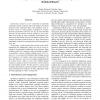237 search results - page 16 / 48 » Which concurrent error detection scheme to choose |
ICC
2007
IEEE
14 years 1 months ago
2007
IEEE
Abstract— We show a statistical pruning approach for maximum likelihood (ML) detection of multiple-input multiple-output (MIMO) systems. We present a general pruning strategy for...
ICIP
2006
IEEE
14 years 9 months ago
2006
IEEE
Most change detection methods are based on gray-level images. A gray-level image is regarded as a 1-D projection of three channels of color images. Therefore, more precise change ...
HVC
2005
Springer
14 years 1 months ago
2005
Springer
Concurrent programs are notorious for containing errors that are difficult to reproduce and diagnose. A common kind of concurrency error is deadlock, which occurs when a set of thr...
ICDCS
2009
IEEE
14 years 2 months ago
2009
IEEE
Concurrency control is a core component in optimistic replication systems. To detect concurrent updates, the system associates each replicated object with metadata, such as, versi...
ICC
2007
IEEE
14 years 1 months ago
2007
IEEE
— In this paper, we propose an optimal metric for detection ordering in terms of symbol error rate (SER) in vertical Bell-lab Layered Space-Time (V-BLAST) systems. Motivated by t...

